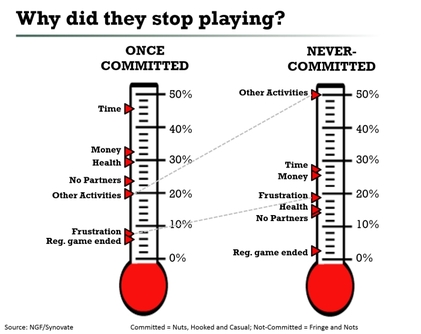Golf participation remained flat in 2012. NGF participation research revealed that there were about 25.3 million golfers in 2012, just off the 2011 figure of 25.7 million. The year over year drop is within error, but the bigger picture - the 4.7 million golfers lost since 2005 and the downward trend in participation - is more alarming.
Many people believe that golf has a problem attracting new blood to the game, but the truth is golf has a retention problem - we’re losing more people than we are gaining.
In a recent study, we asked lapsed golfers (defined as people age 18-69 who have not played in the past two years) what drove them away. The usual suspects, time and money, reared their ugly heads, but we found that reasons for leaving went beyond that. Understanding what turns people off from golf can help those of us in the industry improve the golf experience for everyone and increase the likelihood of retaining new and current golfers.
Before getting into why people leave, let’s look at who we’re losing. Most “lapsed” golfers aren’t really golfers at all. Of the approximate 21 million lapsed golfers, about two thirds were never committed to the game. Most never played 10 rounds in their lives. Once a golfer is committed, the chances of keeping them are very good. (Click here for more on commitment to golf.)

These two types of lapsed golfers - we’ll call them Once Committeds and Never Committeds - left the game for different reasons. The Once Committeds, after the time and money bromides, told us that health and lack of playing partners were the top reasons. Most of the Never Committeds were drawn to other activities where they had more fun. Frustration was also noticeably higher for this group.
The ‘fun factor’ looms large when it comes to retention. Two thirds of lapsed golfers just weren’t having any fun. That can certainly be attributed to any of the reasons they gave for leaving - lack of skill, not being comfortable on the course, frustration, difficulty of the game, etc. And if they’re not having fun, they’re probably not going to perceive much value. Almost 60% of lapsed participants who were never committed told us that they rated the value of golf very low. Conversely, committed golfers rate golf very high on their scale of fun, and perceive great value in the game.
Improving retention will help golf’s participation problem tremendously. Making golfers feel more comfortable on the course is paramount to retention, as is helping beginners feel good enough about their skills to lessen frustrations and eliminate embarrassment. All of this will contribute to making golf more FUN, and build a larger base of committed players. We all fell in love with golf for one reason or another. By doing things that make this sport more welcoming, and being helpful and patient with beginners, others are sure to fall in love with golf as well.